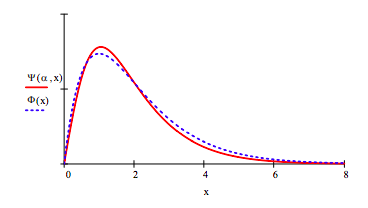10.21: Variation Calculation on the 1D Hydrogen Atom Using a Trigonometric Trial Wave Function
- Page ID
- 136970
The energy operator for this problem is:
\[ \frac{-1}{2} \frac{d^2}{dx^2} \blacksquare - \frac{1}{x} \blacksquare \nonumber \]
The trial wave function:
\[ \Psi ( \alpha , x) := \frac{ \sqrt{12 \alpha ^3}}{ \pi} (x) sech( \alpha , x) \nonumber \]
Evaluate the variational energy integral.
\[ E( \alpha ) := \int_{0}^{ \infty} \Psi ( \alpha , x) - \frac{1}{2} \frac{d^2}{dx^2} \Psi ( \alpha , x) dx + \int_{0}^{ \infty} \frac{-1}{x} \Psi ( \alpha , x)^2 dx |_{simplify}^{assume,~ \alpha > 0} \rightarrow \frac{1}{6} \alpha \frac{12 \alpha _ \alpha \pi^2 - 72 ln (2)}{ \pi ^2} \nonumber \]
Minimize the energy with respect to the variational parameter \( \alpha\) and report its optimum value and the ground-state energy.
\( \alpha\) := 1 \( \alpha\) := Minimize (E, \( \alpha\)) \( \alpha\) = 1.1410 E( \( \alpha\)) = -0.4808
The exact ground-state energy for the hydrogen atom is -.5 Eh. Calculate the percent error.
\[ | \frac{-.5 - E( \alpha )}{-.5}| = 3.8401 \nonumber \]
Plot the optimized trial wave function and the exact solution, \( \Phi (x) := 2 (x) exp (-x)\).

Find the distance from the nucleus within which there is a 95% probability of finding the electron.
\( \alpha\) := 1. Given:
\[ \int_{0}^{a} \Psi ( \alpha , x)^2 dx = 0.95 \nonumber \]
Find (a) = 2.8754
Find the most probable value of the position of the electron from the nucleus.
\[ \alpha := 1.1410~~~~ \frac{d}{dx}|\frac{ \sqrt{12 \alpha ^3}}{ \pi} (x) sech( \alpha , x)| = 0~|_{float,~3}^{solve,~x} \rightarrow 1.05 \nonumber \]
Calculate the probability that the electron will be found between the nucleus and the most probable distance from the nucleus.
\[ \int_{0}^{1.05} \Psi ( \alpha , x)^2 dx = 0.3464 \nonumber \]
Break the energy down into kinetic and potential energy contributions. Is the virial theorem obeyed?
\[ T := \int_{0}^{ \infty} \Psi ( \alpha , x) \frac{-1}{2} \frac{d^2}{dx^2} \Psi ( \alpha , x) dx~~~T = 0.4808 \nonumber \]
\[ V := \int_{0}^{ \infty} \frac{-1}{x} \Psi ( \alpha , x)^2 dx~~~ V = -0.9616 \nonumber \]
\[ | \frac{V}{T}| = 2.0000 \nonumber \]
Use the exact result to discuss the weakness of this trial function.
Eexact := -0.5
Using the virial theorem we know: Texact := 0.500 Vexact := -1.00
Calculate the difference between the variational results and the exact calculation:
E( \( \alpha\)) - Eexact = 0.0192
T - Texact = -0.0192
V - Vexact = 0.0384
The variational wave function yields a lower kinetic energy, but at the expense of a potential energy that is twice as unfavorable as the kinetic energy result is favorable.
Calculate the probability that tunneling is occurring.
Classical turning point:
\[ E( \alpha ) = \frac{-1}{x} |_{float,~3}^{solve,~x} \nonumber \]
Tunneling probability:
\[ \int_{2.08}^{ \infty} \Psi ( \alpha , x)^2 dx = 0.1783 \nonumber \]


